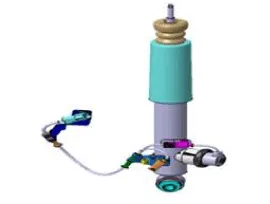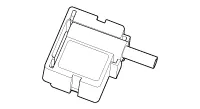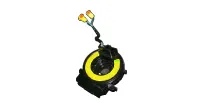Hyundai Genesis (DH): ECS(Electronic Control Suspension) System / Description and Operation
| Description |



| Item | Shape | Function |
| body G-sensor |
| Body motion detection Sky hook damping control(pitch, bounce control) |
| Wheel G-sensor |
| Wheel roughness detection Damper velocity estimation |
| Vehicle Signals | Vehicle Speed Throttle position sensor Brake Steering Angle Drive mode switch signal | |
| Steering angle sensor |
| Estimation Of The Driver's Steering Left/Right acceleration measurements |

| Operation |
Components 1. ECU2. Front Continuously Variable Damper3. Wheel G-Sensors4. Rear Continuously Variable Damper5. Body G-Sensors Components Location ECS-ECU Body G-Sensors [Right Front] [Left Front] [Right Rear] Wheel G-Sensors [2EA] Front Continuously Variable Damper [2EA] Rear Continuously Variable Damper [2EA]
Schematic Diagrams 1. Connector input/output No.DescriptionPin No.Description1Battery(+)20-2Solenoid RL (+)21-3Solenoid RR (+)22-4Solenoid FL (+)23-5Solenoid FR (+)24-6- 25G- sensor power7- 26Body G-sensor signal RR8- 27Body G-sensor signal FL9- 28Wheel G-sensor signal FR10- 29Wheel G-sensor signal FL11- 30Wheel G-sensor signal FR12- 31CAN HIGH 13Ground32-14Solenoid RL (-) 33CAN LOW 15Solenoid RR (-)34-16Solenoid FL (-)35-17Solenoid FR (-)36IGN (+) 18-37-19-38G-Sensor Ground 2.
Other information:
Hyundai Genesis (DH) 2013-2016 Service Manual: Rheostat Repair procedures
Inspection 1. Disconnect the negative (-) battery terminal. 2. Remove the crash pad lower panel. (Refer to Body - "Crash Pad Lower Panel") 3. Remove the lower crash pad switch assembly (A) after disengaging the mounting clip. 4. Remove the rheostat switch connector (A).
Hyundai Genesis (DH) 2013-2016 Service Manual: Ambient Temperature Sensor Description and Operation
Description The ambient temperature sensor is located inside the side mirror and detects ambient air temperature. It is a negative type thermistor; resistance will increase with lower temperature, and decrease with higher temperature. The sensor output will be used for discharge temperature control, temperature regulation door control,
Categories
- Manuals Home
- Hyundai Genesis Owners Manual
- Hyundai Genesis Service Manual
- Electric Parking Brake (EPB) Repair procedures
- Suspension System
- Engine Control / Fuel System
- New on site
- Most important about car



